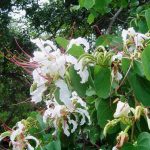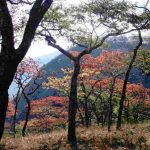TREE LIFE
October 1987
MASHONALAND CALENDER
Sunday October 4th : Wildlife Field Day : As part of the celebrations to mark the Wildlife Society’s Diamond Jubilee Year, the Mashonaland Branch will be hold a WILDLIFE FIELD DAY at the Mukuvisi Woodland.
Programme :
0700 hours Guided foot safari in the game park
0900 hours Talk : Bird migration/bird ringing – Mr. Tony Tree
1000 hours Talk : Crocodiles – speaker Dr. John Hutton
1100 hours Talk : Tortoises – speaker Mrs. Winkie Schmolke
1400 hours Talk : Bees – speaker Mr. Mike Schmolke
1500 hours Talk : Game Capture – speaker Mr. Mike Standish White
1600 hours Guided foot safari in the game park
1600 hours Guided tree walk in the woodland
All Day Snake Display with well known herpetologist Steve Durrant
Wildlife Quiz; Children’Conservation Game, Produce/Plant stall, Bundu Books/t-shirts
Badges, Christmas Cards, Calendars for sale. Come and join us on Sunday 4 October
Tuesday October 6th : Botanic Garden Walk. Meet at the Car Park at 1645 for 1700 hours.
Friday October 16th : THE MAGIC OF MANA
The Aloe, Cactus and Succulent Society of Zimbabwe invite you to join them in a fascinating slide show and talk to be given by Meg Coates Palgrave.
Place : Riembarta Hall on Samora Machel Avenue East at 1930 hours. Turn off Samora Machel Avenue East at Haddon Motors garage and proceed round the corner to the Hall. Cars will be guarded. A donation of $1 per person to cover the cost of hire of the all and security guard will be appreciated. Tea, coffee and biscuits will be served.
Sunday October 18th : GABAZA FARM, Harare South, the farm of Ian and Ellie Burton and the neighbouring farm of the Laing’s. A well developed woodland on granite derived sandveld. East walking between huge granite boulders and amongst riverine trees. We may spend the afternoon comparing some of the huge anthills that are so well developed in this area.
Saturday October 24th : Meeting at Mukuvisi Woodlands. Meet at 1430 hours at corner Paget Road/Inyanga Crescent.
LOST ON THE BUS ON THE CHEGUTU TRIP
If you by any chance picked up Joyce Herring’s book, Common Trees of the Central Woodlands of Zimbabwe, please phone her on 727016.
MATABELELAND CALENDAR
Sunday October 4th : We go to the Matopos to the area behind Efifi. Meet at 0830 hours at Retreat. Bring lunch.
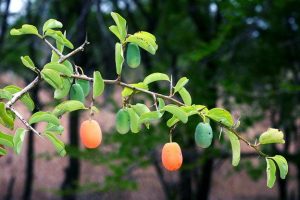
Ximenia caffra. Photo: Bart Wursten. Source: Flora of Zimbabwe
On Sunday September 6th we went to the Circular Drive area, going in from Southway with the kind assistance of Mr. and Mrs. Pumfrey. Although things were pretty dry we identified some fifty species. Of these 7 species were prominently widespread over the whole area : Acacia karroo, Acacia rehmanniana, Euclea natalensis, several flowering, Ozoroa insignis, subsp. reticulata, Tarchonanthus camphorates, Ximenia americana, many flowering Ximenia caffra, some also in flower. We also note Acacia sieberana with its papery peeling bark, and straight thorns. Burkea africana, flowering, Erythrina latissima, with knobby reddish bark, Euclea divinorum, only a few, Euclea undulata, not common here. There were quite a few figs, Ficus ingens, flowering well, Ficus glumosa, Ficus sur, also flowering, Lannea discolor, flowering, Mimusops zeyheri, Olea europea, subsp. africana, Pappea capensis, several, but only very small, Pterocarpus angolensis, Protea gaguedi, Rhus lancea, Schrebera alata, Steganotaenia araliacea, in very elegant flower, Tapiphyllum velutinum, small Terminalia sericea, with galls and various other peculiar growths, Vangueria infausta, Ziziphus mucronata.
-C.Sykes
BOTANIC GARDEN WALK TUESDAY 1ST SEPTEMBER
Unfortunately Tom was not able to get back from a trip to Banket in time for the walk on 1st September but fortunately Kim had returned from his trip to the Valley. A Fernandoa magnifica was in flower and he took the opportunity to talk both about the flowers and the family BIGNONIACEAE.
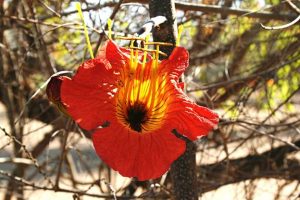
Fernandoa magnifica. Photo: Bart Wursten. Source: Flora of Zimbabwe
The family is mostly tropical and consists mainly of woody species many of which are Lianes. They usually have large showy flowers and compound leaves with a single leaflet at the end – imparipinnate. The leaves are usually opposite, an unusual feature for compound leaves and therefore a diagnostic feature for the family. The leaves can also be in whorls of three.
We are well acquainted with members of the family, BIGNONIACEAE. The exotic species with which we are all familiar are the Jacaranda, Jacaranda mimosifolia from Brazil, the Spathodea, Spathodea campanulata from Kenya and Tanzania; the Tabebuias from tropical and south America, Tababuia serratifolia with yellow flowers and Tababuia rosea with white to deep pink flowers and from South Africa, with orange to red flowers there is Tecomaria capensis, the Cape Honeysuckle.
We started by looking at the flowers of Fernandoa. These are about 8 cm in diameter, bright orange to crimson with a yellow center. They are bat pollinated and we were told that, as this required lots of energy, the flowers produce vast quantities of nectar. This proved to be true and we could see the nectar running down the petals.
When there are 5 sepals and 5 petals there should be 5 to 10 anthers but there were only 4 on the flowers we were looking at, the fifth had become vestigial and is therefore called a staminode. The flower also has bi-lateral symmetry and this is an indication that it is a flower of an advanced family. More primitive flowers have a radial symmetry. The anthers are fused to the petals so that, after pollination, when the petals fall the anthers are also thrown away. Which prompted Kim to remind us that, in nature, the male is often an ecological luxury. The stigma, style and ovary are left behind and the pollen grows down the small style until it reaches the ovary and fertilization takes place.
The sausage tree Kigelia africana bears its flowers on long thin stalks. The flowers are bat pollinated and therefore pollinated in the early evening or at night and in order to ensure that pollination takes place the trees produce a large number of flowers. We counted over 50 buds on one stalk, which certainly did not seem capable of bearing that number of sausages. The Sausage Tree probably overcomes the problem by sending a message to the other flowers to abort as soon as one of them has been fertilized. Occasionally it happens that two flowers on a stem are fertilized at about the same time, and so two fruits grow from the same point. Most of the members of BIGNONIACEAE bear pods like the Markhamia. Inside these can have a partition down the center, which splits the pod in two and the seeds are usually winged. Both these characteristics differentiate them from the pods and seeds of the legumes.
Other indigenous members of the family are Stereospermum kunthianum, the Pink Jacaranda, which should be flowering now on the Escarpment and in the Zambezi Valley. For those who are not able to travel that far there is one in the grounds of Species College in Rhodes Avenue and one in the Main Park just south of the Kiosk. And in the south of the country the Rhigozum should be in bright yellow flower shortly.
Thank you Kim for fascinating us with lore of flowers and for doing so without any warning that you would be called upon to conduct the walk.
-Meg Coates Palgrave
OUTING TO MIDDLETON AND JAMES FARMS, GOROMONZI/RUWA 20TH SEPTEMBER 1987
Man has developed a variety of values derived from trees – the value as timber for furniture, ship building, housing or the aesthetic value of flowering or evergreen trees, or the medicinal value, or the value as fruit bearing trees. In terms of time, however, man’s demands are very recent and of short duration. For hundreds of thousands of years prior to these demands arising, the main use of trees was a food source for animals and insects.
Is it possible that the individual characteristics of many trees are in fact, defensive devices developed to ensure the survival of the species against the onslaught of hungry animals?
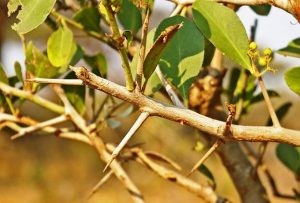
Maytenus senegalensis . Photo: Bart Wursten. Source: Flora of Zimbabwe
The Ten Tree group looked at a variety of trees from this point of view. The vicious thorns on the young growth of Maytenus senegalensis are enough to deter passing animals, the thorns do not occur on mature established branches. Does the milky sap in Ficus sur render this tree’s leaves unpalatable? The red colouring of young growth on the same tree might make it unattractive. The serrations on the edges of the leaves of Ochna schweinfurthiana must make a browser look elsewhere. The leaves of Erythrina abyssinica are thorny on the main veins and on the petioles. Azanza garckiana has rough leaves, while the very softness of the leaves of Combretum molle might make them equally unattractive to a browser.
So next time you are in the bush ask whether the salient characteristics of the trees that you see might offer it protection from a passing buck which would like to use it as an arboreal take-away?
Those members and friends who came on the outing to the Hughes’ and Piercys’ Farms in the Goromonzi area were rewarded with a display of spring foliage and flowers in profusion.
For the statistically minded we found 65 species of trees and the fundis umpteen shrubs and wild flowers, many flowering at ground level.
The most striking of tge trees in flower were two Erythrinas, E.abyssinica and E.latissima. Meg and Kim dissected and studies the flowers and it was decided, without getting too technical, that the main differences between these two are, firstly that E.abyssinica has a thin white rim on the petals, and secondly that the anthers in the E.latissima seem to hang away from the petals.
The cluster of yellow spikey flowers on the ends of the “E.T. fingers” of Lannea discolor were to be seen everywhere and one member drew our attention to L.edulis also flowering, peeping from the side of a rock.
Rhus longipes was largely responsible for the fresh green patches here and there and was flowering and fruiting, the yellowish flowers on little stems and the fruit with its pinched look.
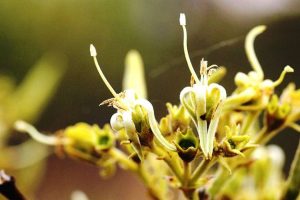
Vangueriopsis lanciflora. Photo: Bart Wursten. Source: Flora of Zimbabwe
The specific name of Vangueriopsis lanciflora became evident when we saw the lance-like flowers and as these trees were leafless it was easy to note the opposite decussate branches growing out on a flat plane from the main trunk and to test the “rubbing” theory.
While scrambling over and around a little kopje we were lucky to be able to compare the three Proteas and P.gaguedi, with smooth green/blue leaves was flowering right on cue. Protea angolensis with pinkish petioles and P.welwitschii with hairy leaves, flower earlier in the year. The flowers of all three varieties are white, unlike their cultivated relations. It was interesting to compare also the three Maytenus species, M.senegalensis, M.undata and M.heterophylla and to see the male and female Uapaca kirkiana the latter laden with fruit which was not yet quite ripe.
After frog marching two of us up a kopje on the other side of a vlei to see something which turned out to be a Tricalysia angolensis, Meg allowed us to rejoin the group to relax and have lunch at a suitable venue provided by a gum plantation on the Piercy’s farm.
The afternoon amble through the nearby bush revealed Pittosporum viridiflorum in fruit, and Ochna schweinfurthiana covered with flower buds which it was estimated would open in a couple of days. It is a pity that we will miss them.
In the afternoon we were able also to compare Syzyium quineense and S.cordatum and we saw and admired the dainty “star burst” flowers of Steganotaenia araliacea, the sweet scented flowers of Branchystegia spiciformis, and the mustard coloured flowers of the much overlooked Parinari curatellifolia.
But in spite of all this the stars of the show for many of us were the msasas, Brachystegia spiciformis in full new leaf of red and bright light green, and a variety of shades in between.
Our thanks go to Mr. and Mrs. Hughes and Mr. and Mrs. Piercy for allowing us to use their farms for a most enjoyable outing.
TREE SOCIETY OF ZIMBABWE AYSHIRE BRANCH
On 1st May 1987 members of the Ayshire Branch of the Tree Society visited Perth Farm, owned by Kythe Nield Forrester. Perth is located in the middle of the 1:50,000 map Raffingora 1730 AZ. The altitude is approximately 3 300 to 4 300 ft. The land surface is one third rock, one third sandy soil overlying granite and the remainder is red clay soil some derived from dolerite dykes and some from sedimentary rocks. The heavier soils border the two rivers, the Mukwadzi and the Susuje. The vegetation is open woodland and herbage clothes old lands which had been used for tobacco and maize.
The nature of this middle veld terrain has prompted the owner to introduce impala to augment the naturally occurring fauna.
Antelope seen on Perth are a) grazers, sable, waterbuck, reedbuck, oribi and steenbok b) browsers, kudu, impala, grey duiker and klipspringer. Time will tell whether these animals are influenced by the Mazwidadei dam; will there be more or fewer on Perth?
We were invited to identify vegetation in four different situations chosen from an area of nearly 6 000 acres. Also, we estimated the frequency of trees; shrubs browsed by wild mammals, this we did whilst driving slowly from place to place. On arrival at the homestead each of us received a list of browse vegetation species compiled from Reay Smither’s book “The Mammals of Southern African Sub Region”.
The four different habitats investigated were as follows :
- a bush clump on an anthill (termitarium)
- environs of a small dam (vlei)
- game fenced open woodland on rocky hillside
- the banks of the Mukwadzi river (riverine).
Browse is defined “growing shoots and twigs used as fodder” also “to feed on leaves and scanty vegetation.
Many game animals relish fresh fallen leaves and fruits which are beneficial to them, but wilted foliage and certain kinds of immature pods may contain poisonous substances which cause death, the animal having died rapidly from lack of oxygen. Recently a dead kudu was found on Perth, plant poisoning may have been the cause of death.
We appeared to be the only creatures lunching in the Game Sanctuary. It was not long before we too were resting in the shade. There was time to look at the list more closely. This revealed absence of species that humans might expect wild animals to eat, such as Sclerocarya (marula), Syzygium (water berries) and Poppea spp. Catholic is the word used to describe the grey duiker’s diet, they will eat paper, tobacco and quickly defoliate rose bushes. Kudu are know to “top” tobacco that is remove the growing point. Crop husbandry and game farming need to be kept apart. Browsers generally have a good reputation with cattle producers because they do not compete for the grazing, grass, and their constant browsing helps to keep down bush encroachment. No hard and fast rule governs feeding habits of game animals, in certain conditions browsers may occasionally graze.
Our hostess hoped we could help her with the check list of grasses eaten by game. During the picnic one flattened tuft of Themeda triandra so that is one more which we might remember, it is of average palatability to cattle but is more important to most of the wild game. Its presence normally denotes that the veld is in good heart, i.e. Kythe has observed impala browze Gardenia and Strychnos spp. These genera have been added to Mr. Smither’s list of browse. Another of her observations concerns rock paintings, many on Perth are of roan antelope which is an endangered species, she wishes to reinstate them on her property.
Later on down at the Mukwadzi river Acacia albida bore masses of unopened flower spikes, soon to open in June. At this unaccustomed altitude the apple ring pods do not form; this is disappointing. We wondered how these trees arrived there. Stan Fourie said it was likely that parrots brought the seed in their droppings. There are Acacia albida saplings in this riverine glade, they were described as “root suckers” from the mature trees. A visit to these Acacias, trowel in hand when the ground is soft will reveal the origin of these young trees. At this point mention must be made of the smell of Acacia roots, something very special, and never forgotten.
Our findings led us to believe that a wider variety and/or an increased number of game could be carried on Perth.
Our survey of the vegetation has enabled us to see the trees on this list, in another dimension, their potential for sustaining wild life. We were fortunate to see nine species of Acacia on one farm in one day. The list of trees and animals is available if anyone would care to see it.
Should this report give rise to feed back please contact Miss K. Nield Forrester, Box 8, Raffingora.
Our thanks to Kythe for an interesting day and the promise of a follow up visit. Laurus mobilis. Charles Dickens addressed American authors on the subject of copyright and said “it is but fair that those who have laurels for their brows should be permitted to browse on their laurels?”
-Benedicta Graves.
EXCERPTS FROM BEYOND SUPERNATURE by LYALL WATSON published by Hodder and Stoughton, 1986
(Reproduced in the interests of Science with acknowledgement and thanks to the Publisher and Author)
It comes from Africa, where a long series of drought years during the early 1980s had a devastating effect on local fauna and flora. Populations everywhere tumbled, but wildlife management officers in South Africa were nevertheless somewhat surprised to learn from farmers in the north western Transvaal that large numbers of kudu were dying. These majestic, spiral horned antelope are normally amongst the more drought resistant species. Despite their size, greater kudu Tragelaphus strepsiceros flourish even on the desert margins, succeeding somehow in browsing a living off vegetation too sparse to support most domestic livestock. So the scientists went to take a closer look.
They found that the deaths were taking place in thorn bush country which was indeed very dry, but by no means poor enough to allow hardy kudu to die of starvation. Post mortem examination of several dead antelope showed that their internal parasite loads were normal and none was suffering from any recognizable disease. Many had apparently adequate quantities of leaves in their digestive tracts, but even these ones were emaciated and seemed to have died from malnutrition. So the problem was passed on to Wouter van Hoven, a physiologist at the University of Pretoria.
Professor van Hoven started by analyzing the nutritional value of the kudu’s usual foods. He found that the protein content of the leaves involved was high, averaging around 14 per cent – enough to keep even the largest antelope healthy. But then he discovered that the protein content of the kudu’s droppings was equally high, indicating that the food had passed straight through their intestines almost undigested …..
The search turned back to the food, to a closer look at the leaves from a dozen species of common bush veld trees – and it soon became apparent that, in addition to their high protein levels, all the plants being eaten were loaded with a group of chemical compounds known collectively as “tannins”. The name comes from the process o tanning, in which fresh hides are turned into more durable leather as their protein molecules are persuaded to combine with certain chemicals to form an insoluble substance that cannot be destroyed by micro-organisms. And the presence of precisely these chemicals in the diet of the kudu was effectively “tanning” their insides, turning off the microbes that encourage normal digestion.
There is, in natural history a long standing relationship between plants and the herbivores that eat them. As evolving animals develop new ways of exploiting vegetable foods, the plants have succeeded in keeping beastly appetites within reasonable bounds by inventing a variety of defensive mechanisms. The most obvious of these are physical deterrents such as heavy bark or sharp thorns, but there are also an impressive array of chemical constraints, including the tannins. These not only make the plants bitter and unpleasant to the taste, but have been carefully designed to interfere with a herbivore’s well being. Some tamper directly with a diner’s digestion producing after effects which can be lethal. Others have a delayed response, one passed on to the second and third generations, particularly of herbivores, such as caterpillars which have been found, after eating tannin loaded leaves, to produce fewer egg masses and weaker and shorter lived offspring …..
The shy kudu normally browse over wide areas, nibbling a bit here and there as they melt away through the bush. Rocks, rivers and barbed wire mean nothing to an antelope that can leap six foot fences without visible effort. But during the last decade an increasing number of game conscious farmers have been erecting more formidable barriers to keep their local wildlife from straying into areas where they run the risk of being shot. The motives are admirable, but the effects have been unfortunate. Confined to limited areas, like caterpillars stuck in a single tree, the critical density seems to be around 100 acres per kudu, the antelope are forced in times of drought to feed more often than they would like from the same few trees.
The trees don’t lie it either. Observation of kudu in an undisturbed area shows that they browse on any one bush or tree for less than two minutes, moving on quickly to the next even though ample and apparently equally appetizing leaves remain within easy reach on the first. Why not continue eating at each feeding site until all the available leaves have gone? The answer is simple. The trees won’t allow it. They put up their chemical defenses – and they do so with astonishing speed.
Kudu are substantial creatures, standing five foot high at the shoulder and weighing over a thousand pounds. They are not gentle feeders, stripping leaves and bark from branches often breaking off twigs in the process. Something a plant is bound to notice. Wouter van Hoven wondered if he could imitate the process and took his students out on tree beating expeditions. The first step was to tiptoe up on a tree and gently take a sample of its leaves. Then, acting on his instructions a mob of students moved in with an assortment of belts whips and canes and thrashed the hapless plants, damaging and stripping their leaves. And finally the scientists stepped in again and took further samples of the leaves at fixed intervals. The results were dramatic. All the abused trees produced extra tannins and moved these into their leaves within minutes. After fifteen minutes, the concentration of tannin in weeping wattle Peltophorum africanum had risen by 44 per cent; in mountain sumac, Rhus laptodictya the increase was 76 per cent; and in the hook thorn, Acacia caffra, it was almost doubled to 94 per cent. An hour after being beaten, the defensive chemical content of wattle leaves had risen by 256 per cent, while that in the acacias soared to 282 per cent above its initial level. Wild pear, Dombeya rotundifolia, bush willow, Combretum hereroese and quarry Euclea undulata all showed similar responses and it took at least 24 hours, in some cases as much as 100 hours, for any of the plants to relax and return to a state of tasty equilibrium.
Under normal circumstances, the rush of tannins to the leaves becomes appreciable to the kudu as a change in taste within the first few minutes of beginning to browse, and it moves on. But when high fences restrict the antelope’s movement and drought restricts its choice, it is forced to return to a limited range of feeding sites at shorter and shorter intervals. Browsing pressures intensify, tannin concentrations remain in dangerously high, digestion suffers and animals starve and die. It is significant that the Pretoria team found a number of dead kudu actually hanging from the offending fences impaled as they made final frantic attempts to move on to fresh fields with access to more palatable and less paranoid plants.
Having solved the riddle of the dying kudu, Wouter van Hoven found himself faced with an extra dilemma. He was careful, in the tests on plants that were deliberately maltreated, to take additional samples from other similar specimens nearby as controls. And he found, to his astonishment, that if these undamaged trees were anywhere near the injured ones, they showed a sympathetic increase in tannin concentration. A small hook thorn of the same size as the one that was thrashed and which stood over six feet away, showed a 42 per cent increase in tannin after three hours. A silver oak, ten feet away produced 14 per cent more tannin within an hour Even the “weeping” of wattle was registered by two other trees within ten feet, which produced high concentrations of tannin soon after a student had belabored their neighbor with his belt.
Van Hoven was unable to explain this apparent ability of trees to raise the alarm and alert others of their kind to the danger of imminent attack. It is anyway just the sort of subject likely to cause equivalent alarm amongst editors of the more conservative botanical journals. So he simply published his observations under the titled of “Trees secret warning system… “ in a popular magazine produced by the South African National Parks Board where it seem to have gone largely unnoticed.
By kind permission of the Editor, ECSS Newsletter.
THE LEAST SUCCESSFUL EXPLORER
Thomas Nuttall (1786 to 1859) was a pioneer botanist whose main field of study was the flora of remote parts of North West America. As an explorer, however, his work was characterized by the fact that he was almost permanently lost.
During his expedition of 1812 his colleagues frequently had to light beacons in the evening to help him find his way back to camp.
One night he completely failed to return and a search party was sent out. As it approached him in the darkness Nuttall assumed they were Indians and tried to escape. The annoyed rescuers pursued him for three days through bush and river until he accidentally wandered back into camp. On another occasion Nuttall was lost again and lay down exhausted. He looked so pathetic that an passing Indian instead of scalping him, picked him up, carried him three miles to the river and paddled him home in a canoe.!!!
THE CULTIVATION OF OLIVES IN THE SUMMER FAINFALL AREA by M.A.Coates with contributions by D. C. Jackson
Although olives, Olea europaea are grown commercially only in countries or areas with a Mediterranean climate, i.e. with cold wet wintes and warm, dry summers, there are nevertheless farmers keenly interested in growing the crop in certain parts of the Transvaal Middleveld.
The adaptability of several cultivars has already been investigated by the Horticultural Research Institute, Roodeplaat It was found that Mission is the only one that can be grown with reasonable chances of success under the summer rainfall conditions prevailing in the Transvaal Middleveld. The uncertain yields and high cost of controlling insects will, however, have to be taken into consideration b all intending growers.
A cold winder, average winter temperature of 10 – 12oC, is essential for olive trees to flower normally. The fact that the Transvaal Middleveld does not always have such cold winters is the main reason for the low yields; the quality of the fruit is, however, not affected.
Olives thrive in any well drained soil provided it is deep enough, clay soils with insufficient nutrients are not suitable. Before panting one should add organic material to the oil and plough it in deep.
Olive cultivars are propagated from cuttings or by grafting or budding on a root stock i.e. the wild olives, Olea africana or Olea verrucosa. The rootstock trees are grown either from seed or from the sucker outgrowths at the base of established trees; the outgrowths, together with a piece of the trunk, 15 – 20 cm., are sawn from the trees. Olive cuttings can be rooted by using the hormone treatment and mist propagation technique. Trees from these cuttings are bigger more uniform and more productive.
A fertilizer programme is recommended for increased production.
The trees must be irrigated before full blossoming in October or November during hardening of the pit in February-March and again before harvesting. One should not irrigate while the fruit is setting because this may result in a poor set. Pruning during the winter preceding the “on year” i.e. the heavy crop year, usually has a favourable effect on the crop of the following year; the pruning reduces the size of the “on year” crop, and so improves the conditions for flowering the next season.
Under favourable conditions the trees start bearing in their third year and reach full production after 8 or 9 years.
Harvesting is the most expensive part in olive production; each fruit has to be hand picked! For preserving, green olives are picked when they reach the desired size; this may mean as many as three pickings. Back olives are picked for preserving when they reach full size and are fully coloured. The fruit ust not be bruised. Olives are harvested for oil when a characteristic white sap readily appears on pressing the fruit. Both preserving and oil extraction must take place within 24 hours of picking.
With acknowledgements to farming in South Africa 1974
-Dick Hicks Chairman


